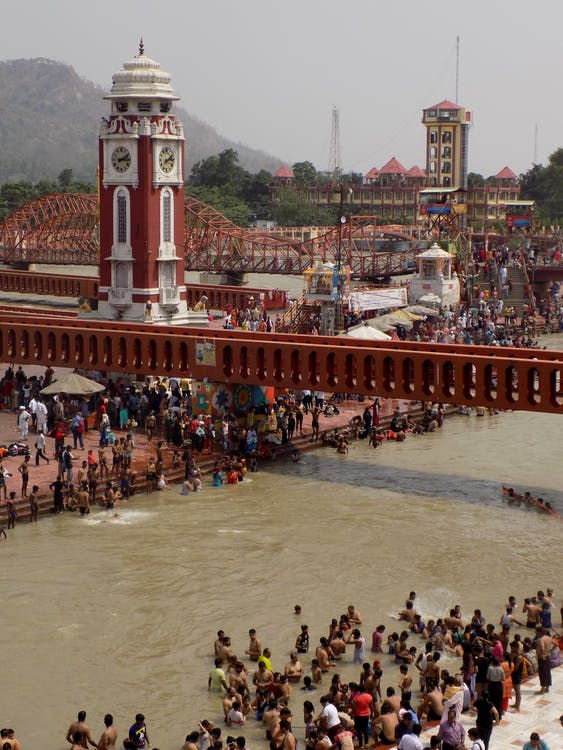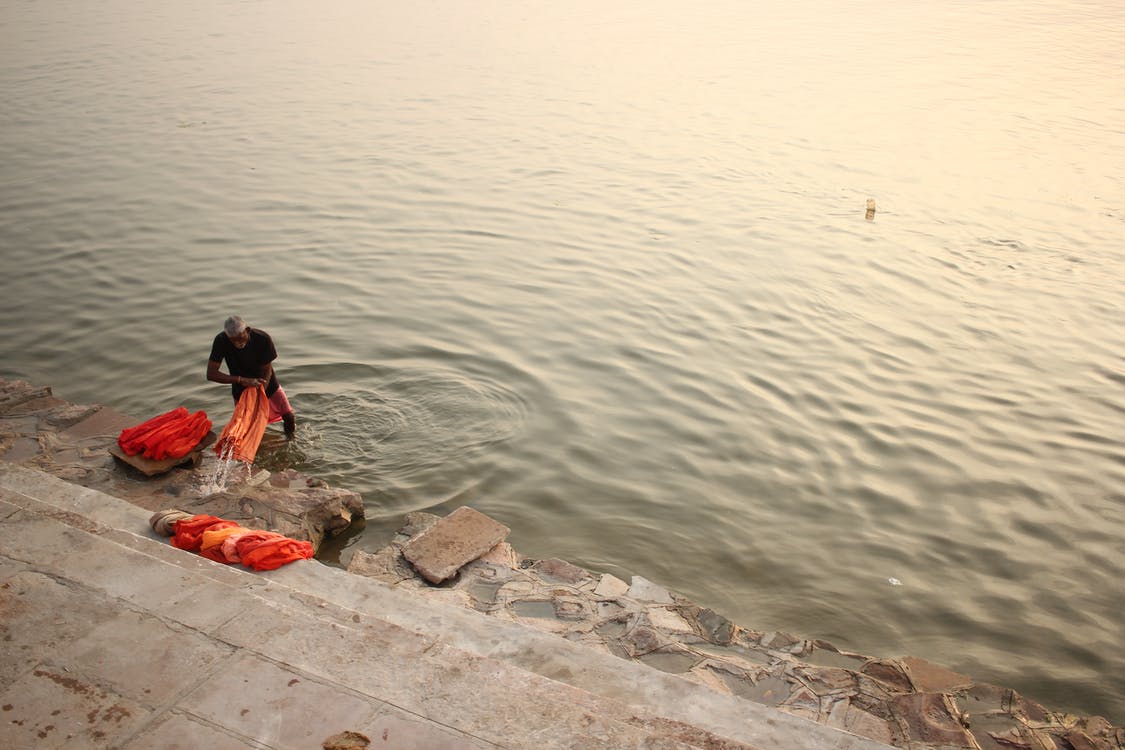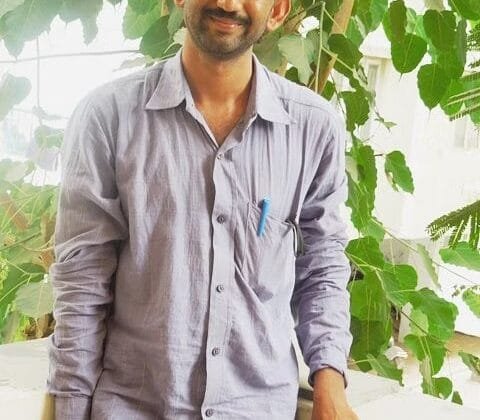“The Ganga is more than a river. She is the Holy Mother. She is Ganga Ma.” -Ronald Barrett

It is a cradle of human civilization. A sacred river that flows for about 2,525 kilometers in India is none other than the ‘Ganga’ river. Its source is the Himalayas, which also create India’s Indus and Brahmaputra rivers. Moreover, the Ganga basin accounts for roughly 26% of India’s geographical area and supports the lives of 43% of people living near the river. It is a river of paramount significance because of its ability to support flora and fauna, promote social and cultural life, and make the land fertile.
Here we will study the present condition of Ganges and how every project in the past has contributed to its improvement. New projects and some critical steps necessary for river rejuvenation are also discussed. Two major problems of the slow pace of the projects with the extinction of river species due to river pollution are further dealt with.
Activists involved in the clean Ganga project
Ganga has been the wellspring of physical and profound food of Indian human progress for centuries. To the Indian brain, River Ganga is a living Goddess, and activists have sacrificed their lives to protect our sacred river. The details are as follows:
- Swami Atmabodhanand puts his life at stake to emphasize the cleaning aspect of our Ganga river. He fasted for many days to seek the attention of the Prime Minister, the Media and the lawful authorities signalling them to take up the initiative to protect our river from further degradation.
He sent several letters to our Prime Minister, for which he never r got any replies. He demands to cancel all new dam construction projects, stop deforestation and mining and make new laws to protect the Ganga River. - GD Agarwal has given life to saving our sacred river. He fasted for 111 days, after which his soul left the earth still fighting for a clean river situation. His demands were similar to Swami Ji’s, but he was also an environmentalist, which gave him immense motivation to seek the betterment of our environment.
- Gopal Das is another brave activist who tremendously contributed to the project to clean the Ganga River. He had similar demands to cancel dam construction, which was the government’s new project.
He also wanted the cutting down of trees and mining to stop and to shift the authorities’ focus towards ensuring the unrestricted flow of the river water so that the earth can heal itself naturally.
Critical steps taken

In November 2019, the National Green Tribunal (NGT) ordered the Uttar Pradesh (UP) government to pay Rs 10 crore for not guarding against sewage discharges containing toxic chromium into the Ganges. The state pollution control board (UPPCB) assessed the cost of damages as compensation for the restoration of the environment and improvement the public health in the region.
UPPCB was also found liable by the NGT and ordered to pay Rs one crore in damages for allowing the discharge of sewage and other effluents containing toxic chromium directly into the Ganga. Further, the Jal Jeevan Mission aims to provide clean water supply to all rural households by 2024 – a greater challenge than upgrading water supply infrastructure in the designated smart cities. Moreover, since India is an agricultural economy, the cumulative use of pesticides has doubled in the last decade, which means more toxic discharge in the rivers.
National Mission for Clean Ganga (NMCG)

This mission aims to rejuvenate the river by improving its water quality by reducing pollution and working towards its decrease in connection to the river waters. Moreover, it aims to develop coordination amongst the different sectors close to the river for the planning and management of river projects and plans.
This mission has the objective of reducing pollution and rejuvenating the Ganga River. Water quality and environmentally sustainable development could be achieved by promoting the intersection of planning and management to provide comprehensive planning & management and minimal ecological flow in the river. Moreover, in December 2020, the NMCG finished 22 tasks and endorsed 17 new undertakings connected with sewerage foundation, contamination reduction, afforestation, and biodiversity at a complete expense of Rs. 557 crore (US$ 75.6 million).
The slow pace of projects

The ‘namami gange’ was a Ganga cleaning project started in Uttrakhand in 2014. The project had a deadline of the year 2019 to build sewage treatment plants and clean the river water of its foul smell due to the waste accumulated on the river bed. However, this project never fulfilled its obligations on time, and the sluggish efforts from the government did nothing to improve the conditions of the river water.
Over time, the project has failed because of inadequate efforts and dedication. As of May 13, 2015 – the date of Namami Gange’s approval by the Union Cabinet – Namami Gange had completed 114 projects, and more than 150 were in progress, while about 40 projects are on the tender. Of these, 51 sewage projects were approved before that date. In 97 Ganga towns, 1,930 MLD of sewerage treatment capacity has been developed, while 2,953 MLD of sewerage is generated. By 2035, 3,700 MLD of sewage will be produced.
Funds spent on the Namami Gange project
The total monetary cost is Rs.20,000 crore to achieve the twin targets of successful reduction of contamination, protection, and revival of the National River Ganga and its feeders. By February 2019, almost Rs 6,000 crore ($860 million), or 30% of the Rs 20,000 crore plan, had been spent on the mission to clean the Ganga. However, the river stays as contaminated as could be expected.
Around 67% of costs so far have gone into further developing sewage organizations and treatment units in riverside urban communities; however, just somewhat above 10% of the necessary limit has been made. As of May, the most recent figures accessible — ₹28,451 crores have been endorsed for different tasks, yet just about ₹6,955 crores (around 25%) has been spent. Of the 298 tasks, just 99 had been finished. The deficient activities are reflected in the stream quality.
Extinction of river species
The Wildlife Institute of India, which is situated in Dehradun, has announced a report which states that at least ten species in the river, such as dolphin and the crocodile, are on the verge of extinction. Moreover, if things weren’t looking bad enough for the river, a new project is in its beginning stages where river transportation is supposed to revolutionize traveling in India.
More boats and ships will be cost-effective and serve the purpose of transporting the people of India. However, a concern arises when it leads to the destruction of various slow-moving and delicate species of flora and fauna that have the river as their home.
Furthermore, birds such as the black-bellied tern and Indian skimmer; turtles such as the northern river terrapin, three stripped roofed turtle, red-crowned roofed turtle; and the golden mahseer fish are also believed to be on the verge of extinction. Additionally, the sarus crane, the mugger crocodile, and the snow trout are also in danger.
Conclusion
In India, river management lacks basin-wide integration and cooperation between the land members. Ganga River is a prestigious and sacred river that the people of India religiously revere. The Supreme Court has warned the Centre to take drastic measures towards cleaning the river Ganga before it is too late to save India’s species and the birds and people.
Moreover, with the slower pace or systemic failure of the previous governmental projects, India will not be able to clean its river Ganga even in 200 years, added the Supreme Court of India.
Now the newest plans of the National Mission for Clean Ganga have to be implemented quickly and strategically. Apart from the government’s efforts, the population of India can also prove to be helpful. Our population is so dense that if every person came together to implement changes in the river’s water quality by cleaning the river banks of waste and taking care of their sewage waters, there would be a drastic change in our river Ganga.
If we don’t collectively act now, we will lose many precious wild species of birds and aquatic creatures dependent on the river and the river itself, and the loss will haunt us for centuries.

 Add to favorites
Add to favorites








